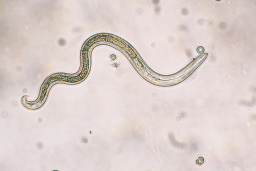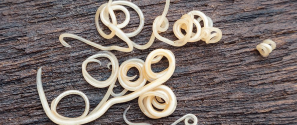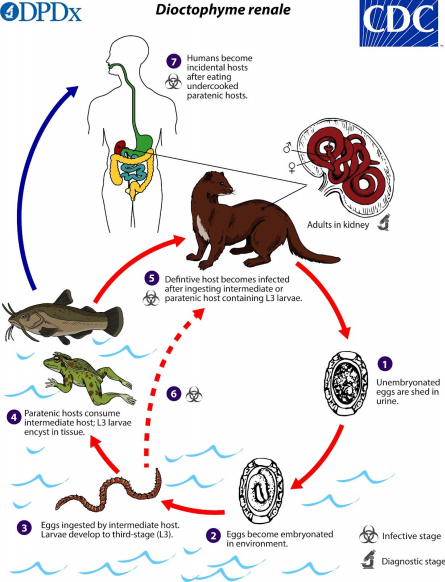Guest Writer: River Otter Research
River Otters, Roundworms, and Environmental Connections
Claire Benson
College of Food, Agriculture, and Natural Resources Science
University of Minnesota '22
Otters are charismatic, semiaquatic mammals often spotted near water. Their playful behaviors and curious nature make them a favorite for many people. Even their tracks in winter snow, alternating between staccato footprints and long dashes of belly slides, make it look like otters know how to enjoy life.
Background
Otters are in the scientific family Mustelidae. Mustelidae is a group of closely related carnivorous mammals with common characteristics. Members of this family usually have short legs, elongated bodies, and thick fur. Examples of mustelids include badgers, weasels, marten, and River otters. There are 13 species of otters worldwide. They are found in and around freshwater wetlands, lakes, rivers, and coastal marine environments.
The River otter (Lontra canadensis) is Minnesota's largest semiaquatic carnivore. An adult River otter weighs an average of 15-19 lbs. and is around 2-4 feet in length, including their tail (River otter, DNR). Elongated bodies, webbed feet, and long tails are useful for swimming. River otters have whiskers to help them find prey in turbid waters. Their webbed feet also have sharp claws to grab and manipulate prey (North American River Otter, NWF). A long tail helps propel otters though the water. A narrow body and flat head allows for streamlined movement and flexibility as needed when making sharp turns to follow prey such as crayfish, fish, insects, frogs, and other small mammals. River otters are able to stay underwater for as long as 8 minutes. This suite of characteristics help otters to be proficient predators and accomplished swimmers.
Generally, male and female otters are together for only a brief period of time during the mating season. The female stays with her young for extended periods, while males may form their own groups. Otters can be found socializing in these groups and are known for their playful behavior. Research shows that River otters play improves hunting ability and strengthens social bonds (North American River Otter, NWF). They will slide down muddy or snowy hills, chase tails, burrow in snow and play in the water. High sociality may also support parasite spread in groups (Kołodziej-Sobocińska, 2019).
Roundworms and otters
Roundworms are a common type of parasite found in otters. In the phylum Nematoda, there are around 25,000 species of roundworms. Roundworm bodies are tubular, unsegmented, and covered by a thin cuticle. The cuticle acts as a protective coating that is permeable to gases, water, and some ions. They have a pseudocoelom, which is a fluid-filled body cavity lying inside the external body wall that surrounds the internal organs, and a complete digestive tract.


(Moorhead DVM, 2020)
Roundworms and other parasites have life cycle variations that include different types of hosts. Intermediate hosts are involved during parasite growth and development, while definitive hosts are final hosts where parasites reach sexual maturity and reproduce. An example of a parasitic life cycle that includes both host types occurs when a fish that serves as an intermediate host for a roundworm to develop. Then an otter eats the fish and becomes the definitive where the roundworm sexually reproduces.
In the giant kidney roundworm life cycle (illustrated below), parasite eggs are released in the urine of the definitive host such as an otter. An invertebrate, such as an earthworm, ingests the eggs, and the eggs hatch inside the host’s digestive tract. If the earthworm is eaten by another intermediate host, such as a fish, the giant kidney worm larva will produce a cyst around itself in the fish’s tissue and stop developing. When an otter comes along and eats that fish, it gets the parasite too. Once consumed by an otter, the giant kidney worm larvae migrate to the liver and kidney of the otter, where they become adults in about 6 months. The kidney worms sexually reproduce, and then the cycle continues. (CDC - DPDx - Dioctophymiasis2019).
(CDC - DPDx - Dioctophymiasis 2019)
When inside an otter or other animals, roundworms can migrate through the bloodstream to a variety of places in the body such as the lungs, brain, muscles, heart, liver, or eyes. At high numbers, roundworms can cause respiratory issues, anemia, tissue damage, inflammation, and other infections. Otters have been documented with cranial lesions that are thought to have possibly been caused by roundworms (Kimber & Kollias, 2000). Parasites ingested by otters can also affect animals that may prey on otters. Generally, healthy otters have few potential predators. However, young pups and older otters may be preyed upon by wolves, bobcats, cougars, and birds of prey (Longevity & Causes of Death, Seaworld).
There are generally no health effects on humans because of roundworms in otters. However, pets, such as dogs and cats that may come into contact with otter scat, may pick up these parasites. Generally adult dogs and cats don't show clear symptoms, but younger animals may have weight loss, bulging stomachs, coughing, malnourishment, and vomiting (Paddock, 2020). Humans that are most susceptible to getting roundworm infection, known as toxocariasis, are children, dog or cat owners, or people who accidentally consume soil when gardening or doing other outdoor activities. Toxocariasis can cause serious illnesses including eye disease and organ damage. However, severe cases are rare and can be treated with antiparasitic drugs.
Otters are playful carnivores that win over the hearts of many. They are also susceptible to various parasites such as roundworm that can affect their health and other wildlife. Otters are hosts to other types of parasites besides roundworms too. Refer to the results of VLAWMO’s otter parasite pilot study to learn more.
Sources
- CDC - DPDx - Dioctophymiasis. (2019, June 17). Retrieved November 08, 2020, from https://www.cdc.gov/dpdx/dioctophymiasis/index.html
- CDC - Toxocariasis - Diagnosis. (2019, September 03). Retrieved November 08, 2020, from https://www.cdc.gov/parasites/toxocariasis/diagnosis.html
- DNR- River otter. (n.d.). Retrieved November 08, 2020, from https://www.dnr.state.mn.us/ mammals/riverotter.html
- Kimber, K. R., & Kollias, G. V. (2000). Infectious and parasitic diseases and contaminant-related problems of North American river otters (Lontra canadensis): a review. Journal of Zoo and Wildlife Medicine, 31(4), 452-472.
- Kołodziej-Sobocińska, M. (2019). Factors affecting the spread of parasites in populations of wild European terrestrial mammals. Mammal Research, 1-18.
- Longevity & Causes of Death. (n.d.). Retrieved November 08, 2020, from https://seaworld.org/animals/all-about/otters/longevity/
- Moorhead DVM, A. (2020, June 26). Roundworms in Dogs: Diagnosis, Treatment, and Prevention. Retrieved November 08, 2020, from https://todaysveterinarypractice.com/roundworms-in-dogs/
- North American River Otter. (n.d.). Retrieved November 08, 2020, from https://www.nwf.org/Educational-Resources/Wildlife-Guide/Mammals/north-american-river-otter
- Paddock, A. (2020, February 06). Symptoms and Treatment of Roundworms in Dogs. Retrieved November 08, 2020, from https://www.akc.org/expert-advice/health/roundworms -in-dogs-symptoms-treatment-and prevention/
VLAWMO Urban Otter Health Study
VLAWMO makes it a priority to better understand our wetlands in a variety of ways. One way we do that is by conducting research on indicator species. Indicator species tell us something special about the environment in which they live. Some species such as River otters are indicators of habitat health and water quality. In our River otter project, we are asking about the behavior and health of urban otters compared to rural otters. We know that otters are present in our watershed. We wonder: Are they as healthy as otters living in more pristine habitats? In our urbanized watershed, which wetland areas are most important for urban otters? Can we use our information about otters to better inform wetland preservation and restoration efforts?

